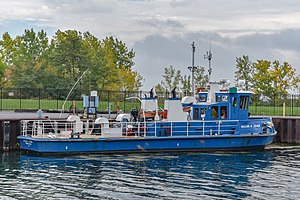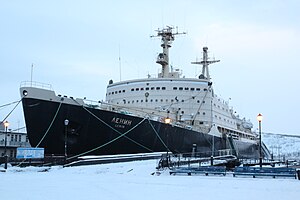Icebreaker

An icebreaker is a vessel whose design includes the ability to break through a layer of floating ice.
Icebreakers range in size. The smallest are the size of tugboats, and may serve as tugboats, with icebreaking a secondary mission.
Most icebreakers break ice to form a safe path for more vulnerable vessels to follow, on a waterway impeded by a layer of floating ice. However, some icebreakers, like the like the New York Power Authority's William H. Latham, are employed keeping water inlets clear of ice.
Some smaller vessels are only required to break layers of ice mere inches thick.
The largest icebreakers can break layers of ice close to two meters thick. The Soviet Union and Russia built very large nuclear powered icebreakers, with engines capable of generating over 50,000 horsepower. The Soviet Union's Lenin was the world's first nuclear powered icebreaker. Russia currently operates half a dozen nuclear powered icebreakers, in the Arctic.
Large icebreakers have thick, heavily reinforced hulls, and really heavily reinforced bows. To break ice too thick for continous passage thes vessels are designed to be capable of breaking thick ice by backing up, and ramming.
Most large icebreakers have special icebreaker bows. the draft at the bow is less than the draft of the rest of the vessel. These vessels ride up over thicker ice, and break that ice through the weight of the vessel. In the early 2000s ship designers from Finland experimented with a different icebreaker design. These vessels had conventional bows, because, when icebreaking, they proceeded stern first. These vessels were propelled by very robust azipods. A strong icebreaking keel was relied upon to break thinner ice. For particularly thick ice robust propeller blades in those azipods were designed to chip away at the ice.
Most large icebreakers rely on cold water temperatures to cool their engines, and cannot proceed at full speed in warmer water.[1] Russia's nuclear icebreakers are restricted to the high latitudes of the Northern hemisphere, and cannot proceed to the Antarctic, because their engines cannot be sufficiently cooled in tropic waters.
References
- ↑ Murray Brewster. Canadians stay to fix U.S. buoys, Globe and Mail, 2005-09-29. Retrieved on 2022-08-04. “Since its diesel engines are configured to work in frigid Arctic waters, the ship has to operate at a reduced speed to avoid overheating.”
